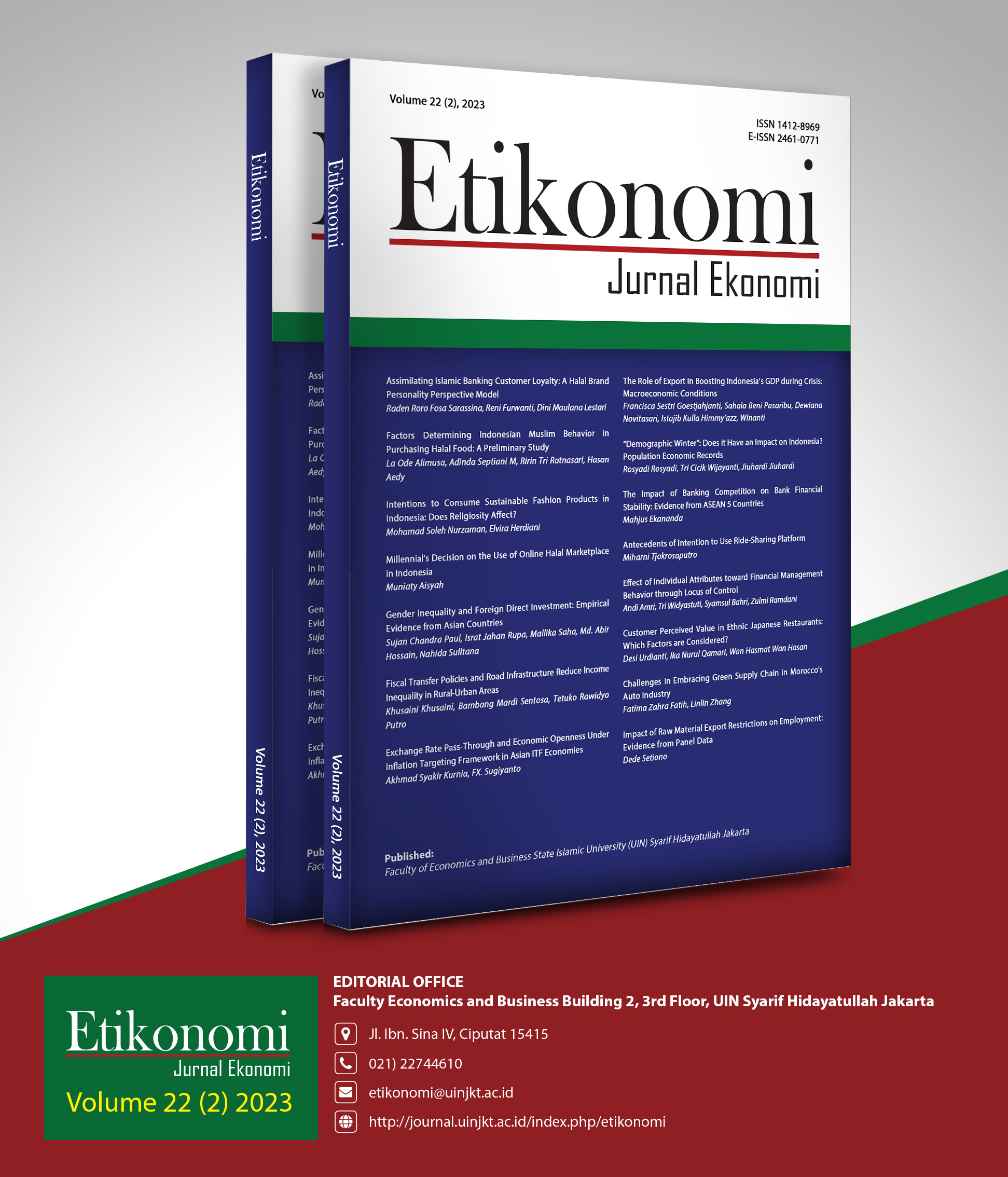Intentions to Consume Sustainable Fashion Products in Indonesia: Does Religiosity Affect ?
DOI:
https://doi.org/10.15408/etk.v22i2.34281Keywords:
consumer behavior, environment, religiosity, sustainable fashion, , theory of planned behaviorAbstract
Religiosity is expected to be a positive driving factor of consumption demand for environmentally friendly fashion products. However, few studies have been found that focus on consumer behavior in purchasing sustainable fashion, and none use religiosity as an explanatory variable. This study, therefore, is the first to analyze the effect of religiosity on the intention to consume sustainable fashion products. This study used a quantitative approach with the Structural Equation Modelling (SEM) analysis method and involved 522 respondents in Indonesia. By adopting the theory of planned behavior model, the study results show that religiosity significantly positively affects purchase intentions of sustainable fashion products through the variables' attitude towards behavior and perceived behavioral control. At the same time, the green thinking variable also has a positive impact, but altruism is irrelevant to sustainable fashion consumption. These results indicate that if the consumer is religious, this can lead to a better environmentally friendly attitude and result in a tendency to consume sustainable fashion products.
JEL Classification: D12, D90, Z12
How to Cite:
Nurzaman, M. S., & Herdiani, E. (2023). Intentions to Consume Sustainable Fashion Products in Indonesia: Does Religiosity Affect? Etikonomi, 22(2), 277 – 292. https://doi.org/10.15408/etk.v22i2.34281.
Downloads
References
Ahmad, A. N., Abd Rahman, A., & Ab Rahman, S. (2015). Assessing Knowledge and Religiosity on Consumer Behavior towards Halal Food and Cosmetic Products. International Journal of Social Science and Humanity, 5(1), 10-14.
Ajzen, I. (1991). The Theory of Planned Behavior. Organizational Behavior and Human Decision Processes, 50(2), 179–211.
Ali, F., Ashfaq, M., Begum, S., & Ali, A. (2020). How "Green" Thinking and Altruism Translate into Purchasing Intentions for Electronics Products: The Intrinsic-Extrinsic Motivation Mechanism. Sustainable Production and Consumption, 24, 281-291.
Brandao, A., & Costa, A. G. D. (2021). Extending the Theory of Planned Behavior to Understand the Effects of Barriers Towards Sustainable Fashion Consumption. European Business Review, 33(5), 742-774. https://doi.org/10.1108/EBR-11-2020-0306.
Brown, S. (2010). Eco Fashion. Laurence King Publishing.
Chaudhary, R., & Bisai, S. (2018). Factors Influencing Green Purchase Behavior of Millennials in India. Management of Environmental Quality: An International Journal, 29(5), 798-812. https://doi.org/10.1108/MEQ-02-2018-0023.
Ellen MacArthur Foundation. (2020). Vision of a Circular Economy for Fashion. Retrieved from: https://ellenmacarthurfoundation.org/topics/fashion/overview
Fashion United. (2022). Global Fashion Industry Statistics - International Apparel. Retrieved from: https://fashionunited.com/global-fashion-industry-statistics/
Fischer, K. (2008). Sustainable fashion and textiles: Design Journeys. United Kingdom: Routledge.
Fishbein, M., & Ajzen, I. (1975). Belief, Attitude, Intention, and Behavior: An Introduction to Theory and Research. Reading, MA: Addison Wesley
Greenpeace. (2016). Greenpeace East Asia: 2016 Annual Report. Retrieved from: https://www.greenpeace.org/eastasia/publication/2834/annual-report-2016.
Guéguen, N., & Stefan, J. (2014). Green Altruism”. Environmental Behavior, 48(2), 324–342.
Hair, J., Black, W., Babin, B., & Anderson, R. (2019). Multivariate Data Analysis (8th ed.). New Jersey: Cengage Learning.
Hasan, Z., & Lehar, H. (2011). Fundamentals of Microeconomics. United Kingdom: Oxford University Press.
Henninger, C., Alevizou, P., & Oates, C. (2016). What is Sustainable Fashion? Journal of Fashion Marketing and Management, 20, 327-331.
Hodson, M. & Hodson, M. (2017). 6 Approaches to Christian Environmental Ethics Part 3. Retrieved from: https://goodfaithmedia.org/6-approaches-to-christian-environmental-ethics-part-3-cms-24114/
Hughner, R. S., McDonagh, P., Prothero, A., Shultz, C. J., & Stanton, J. (2007). Who Are Organic Food Consumers? A Compilation and Review of Why People Purchase Organic Food. Journal of Consumer Behaviour, 6 (2-3), 94–110. https://doi.org/10.1002/cb.210.
Hunt, J., & Penwell, D. (2008). AMG's Handi-Reference World Religions and Cults. Chattanooga: AMG Publishers.
IDN Research Institute. (2022a). Indonesia Gen Z Report 2022. Retrieved from: https://www.imgs.idntimes.com.
IDN Research Institute (2022b). Indonesia Millennial Report 2022. Retrieved from: https://www.imgs.idntimes.com.
Jain, S., Khan, M. N., & Mishra, S. (2017). Understanding Consumer Behavior Regarding Luxury Fashion Goods in India based on The Theory of Planned Behavior. Journal of Asia Business Studies, 11(1), 4–21. https://doi.org/10.1108/JABS-08-2015-0118.
James, W. (2004). The Varieties of Religious Experience. New York: Touchstone.
Khan, M. (1995). Essays in Islamic Economics. Jeddah: The Islamic Foundation
Khan, M. (2013). The Framework for Islamic Theory of Consumer Behavior. Journal of Islamic Banking and Management, 4(1), 17-54
Liu, Y., Segev, S., & Villar, M. E. (2017). Comparing Two Mechanisms for Green Consumption: Cognitive-Affect Behavior vs Theory of Reasoned Action. Journal of Consumer Marketing, 34(5), 442–454. https://doi.org/10.1108/jcm-01-2016-1688.
Loehlin, J. C. (1998). Latent Variable Models: An Introduction to Factor, Path, and Structural Analysis. New Jersey: Lawrence Erlbaum Associates.
Madni, A. R., Hamid, N. A., & Rashid, S. M. (2016). An Association Between Religiosity and Consumer Behavior: a Conceptual Piece. The Journal of Commerce, 8(3), 58-65.
Malhotra, N. K., & Dash, S. (2016). Marketing Research An Applied Orientation (7th ed.). New Delhi: Pearson India Education.
Malhotra, N., & Birks, D. F. (2007). Marketing Research: An Applied Approach. New Jersey: Pearson Education.
McKinsey & Company. (2016). Style that’s sustainable: A new fast-fashion formula. Retrieved from: https://www.mckinsey.com/capabilities/sustainability/our-insights/style-thats-sustainable-a-new-fast-fashion-formula.
McKinsey & Company. (2020). Fashion on Climate. Retrieved from: https://www.mckinsey.com/industries/retail/our-insights/fashion-on-climate.
Morel, K. P., & Pruyn, A. T. H. (2003). Consumer Skepticism Toward New Products. Association for Consumer Research, 351–358.
Sarre, P. (1995). Towards Global Environmental Values: Lessons from Western and Eastern Experience. Environmental Values, 4(2), 115–127.
Shen, D., Richards, J., & Liu, F. (2013). Consumers’ Awareness of Sustainable Fashion. Marketing Management Journal, 23(2), 134-147.
Shiddiqi, M. (2000). Economic Enterprise in Islam. New Delhi: Markazi Maktaba Islami Publishers.
Sutikno, V., Indarini, & Margaretha, S. (2020). Young Consumer's Purchase Intention Toward Environmentally Friendly Products in Indonesia: Expanding the Theory of Planned Behavior. Advances in Economics, Business and Management Research, 115, 36-40. https://doi.org/10.2991/aebmr.k.200127.008.
Wang, L., Wong, P. P. W., & Elangkovan, N. A. (2020). The Influence of Religiosity on Consumer’s Green Purchase Intention Towards Green Hotel Selection in China. Journal of China Tourism Research, 16(3), 1-27. https://doi.org/10.1080/19388160.2019. 1637318.
Wijanto, S. H. (2008). Structural Equation Modelling dengan LISREL 8.8: Konsep & Tutorial. Yogyakarta: Graha Ilmu.
Wu, H.-C., Cheng, C.-C., Chen, Y.-C., Hong, W. (2018). Towards Green Experiential Loyalty: Driving from Experiential Quality, Green Relationship Quality, Environmental Friendliness, Green Support and Green Desire. International Journal of Contemporary Hospitality Management. 30(3), 1374–1397. https://doi.org/10.1108/ijchm-10-2016-0596.










